One of the largest issues facing our democracy this year may not have much to do with the White House. Around the country, in courts, legislatures, the media, and polling places, Americans are grappling with gerrymandering. Citizen-led campaigns to fight against this anti-democratic practice are popping up across America, including in one of the most gerrymandered states in the country: Ohio.
Here’s how gerrymandering works and how it’s impacting voters in Ohio.
What is gerrymandering?
As people move and populations shift over time, states have to draw new district maps to reflect these changes. The process of redrawing district maps is known as redistricting.
When redistricting goes wrong, it’s called gerrymandering.
Gerrymandering happens when politicians redraw district lines in a way that’s designed to get themselves re-elected, rather than represent the population of a district. And because these maps are only redrafted once every ten years, skewed districts can skew voting and political power for an entire decade.
Politicians use two techniques to gerrymander districts: packing and cracking.
- “Packing” is where the people redrawing districts isolate a group of voters by “packing” most of them into a single district. This makes it so that there are fewer members of that group voting in surrounding districts.
- “Cracking” is done by splitting concentrated groups into multiple districts, diluting their numbers in any one district so that elections become uncompetitive.

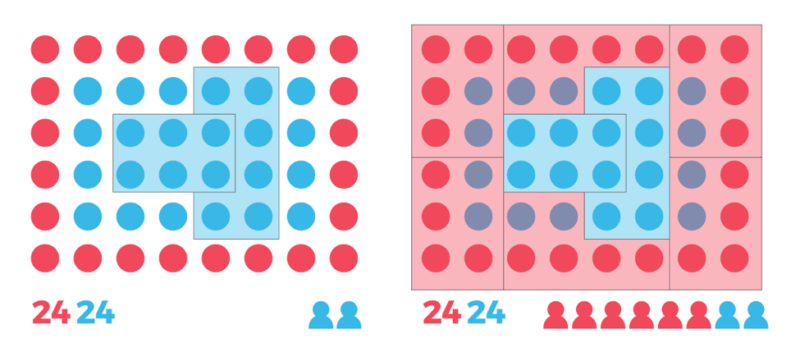
Packing and cracking often require carving cities or counties up very precisely, which is one reason why gerrymandered districts snake, curl, and bend in awkward ways.
Three Common Types of Gerrymandering
That’s right — gerrymandering is such a common practice that there are actually several types of gerrymandering, named after the groups they are designed to benefit or harm. Yikes. Here they are:
- Racial gerrymandering happens when the people in charge of redistricting draw maps in a way that dilutes the voting power of a racial group.
- Partisan gerrymandering is when politicians or appointees draw district lines that skew the political representation so that one political party has an unfair advantage over the other.
- Bipartisan or “sweetheart” gerrymandering takes place when incumbent politicians of different parties come together to create districts that allow them to easily win re-election.
Sometimes districts can be legally gerrymandered to give minority communities the chance to elect their chosen candidates. After a long history of racial disenfranchisement, the Voting Rights Act was designed to allow states to craft minority opportunity districts, where racial and ethnic minorities have the chance to elect a candidate of their choosing. These districts are also known as majority-minority districts. Ohio’s 11th Congressional District, pictured below, is the only majority-minority district in Ohio.
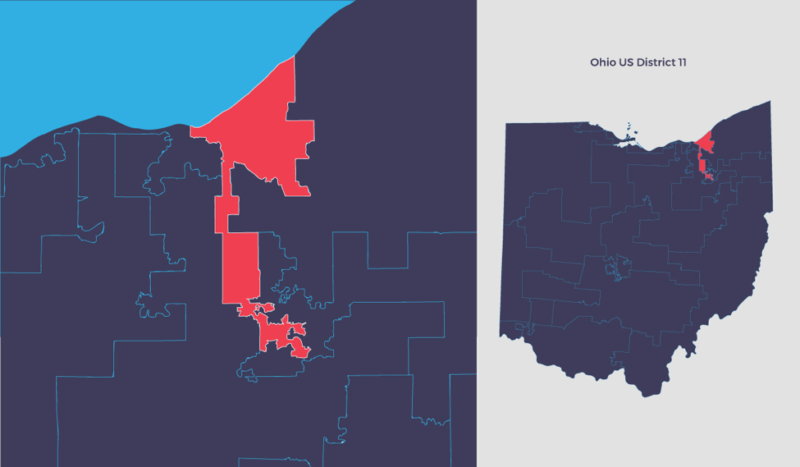
Here’s Ohio’s 11th Congressional District, in the northeastern part of the state.
How does gerrymandering affect voters in Ohio?
Ohio is regularly on the “Top 10 Most Gerrymandered States” lists published by political researchers. And because of gerrymandering, none of Ohio’s congressional districts have competitive elections — that means even before the election begins, we know which party or candidate is going to win. In the 2016 election, the closest race had a gaping 18.4 point margin.
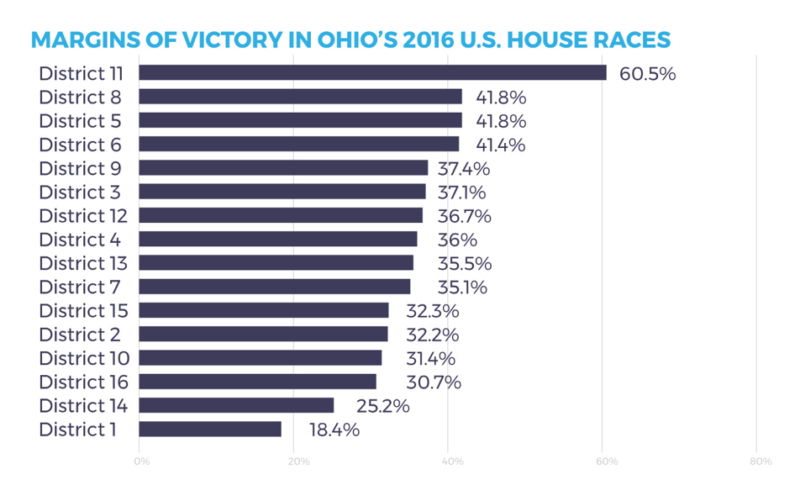
None of the elections were particularly close, either. In the majority of races, the winners garnered at least 35 percentage points more than their opponents, and the smallest margin of victory was 18.4 percent. Looking at elections from 1972 to 2016, Rich Exner noted in cleveland.com that he “could not find a time when there was less competition between the two parties.”
When politicians and different political parties can guarantee their re-election, there’s no incentive for lawmakers to be accountable to the voters — and there’s no mechanism for the voters to hold elected officials accountable.
But gerrymandering affects more than electoral competitiveness.
Ohio’s wonky districts
Ohio’s districts are also more stretched and contorted than average. Azavea, a geospatial research company, ranked Ohio 11th on its list of the states with the least compact congressional districts in the country. Ohio’s 9th Congressional District, below, was named in the nation’s 10 least-compact districts.
You may have heard of that district called the “Snake by the Lake.” When district maps were redrawn in 2011, the new 9th forced two Democratic incumbents, Reps. Marcy Kaptur and Dennis Kucinich, into the same primary election. By eating up little pieces of major population centers, snaking districts can be used to pit officeholders against one another.

Ohio’s 9th Congressional District covers much of the Lake Erie shorefront.
Winding, sprawling districts are more than just strange to look at – they’re a sign gerrymandering may be in play. These distorted district lines can have real consequences for voters. In a gerrymandered map, people one town or neighborhood over may have elected officials who better represent the area’s shared interests. Take Summit County, for example. It’s the fourth-most populous county in Ohio, but the area is subdivided into four congressional districts. None of the officeholders live within its borders.
What are Ohio’s most gerrymandered districts?
Individual district lines can make it easier to see what gerrymandering looks like close-up. Based on the Washington Post’s 2014 analysis of gerrymandering in congressional districts around the country, here are Ohio’s three worst offenders.
District 3
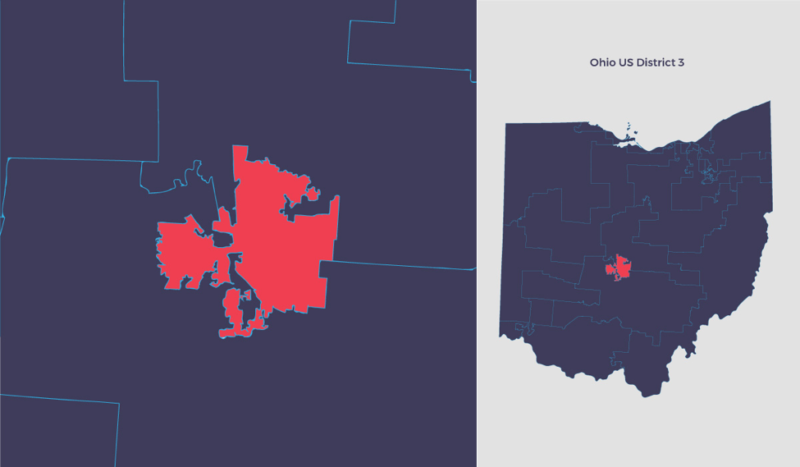
District 3 includes much of the city of Columbus.
District 13

The 13th Congressional District stretches from Akron and Summit County across eastern Ohio to Youngstown and the Pennsylvania border.
District 16
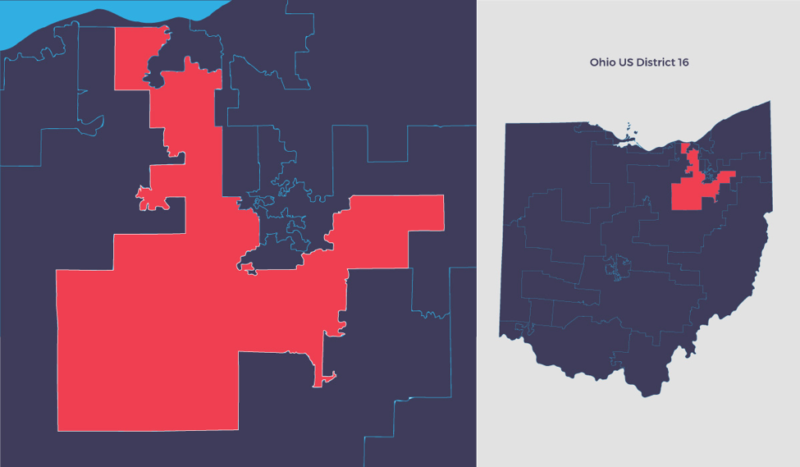
District 16 dances around the Cleveland and Akron metropolitan areas in northeastern Ohio, and also includes a portion of Summit County.
But there is some good news!
In 2018, the people of Ohio passed an initiative to prevent gerrymandering in Congressional districts. This initiative:
- Forces bipartisan agreement about where district lines are drawn.
- Requires that district drawing happens publicly and with input from voters – not behind closed doors.
- Added a rule to the Ohio constitution that districts cannot be drawn to favor or disfavor a political party or its incumbents.
This win in Ohio was a significant victory in the national fight to stop gerrymandering – and there is currently an important bill in the Senate aiming to implement these policies nationwide.
It’s not just snaking districts…
Gerrymandering makes for more than wonky maps — distorting district lines creates uncompetitive elections, divides communities, and limits representation for voters. Our political system depends on accountability, but skewed elections remove the biggest check the people have on politicians. That’s a problem for all Americans.
It’s crystal clear that gerrymandering is in the spotlight right now. From rallies to Supreme Court cases to comprehensive anti-gerrymandering bills, there’s serious momentum behind addressing it. And redistricting reform is an issue that’s unifying all of us, regardless of political party, because everyone loses in a broken system.